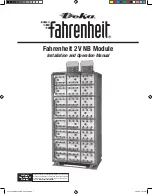
15
For top terminal assembly, align protective cover in front of top
terminal plates. Mark area of protective shield that is required to
be removed in order to fit between the terminals. Cut protective
cover along marks.
Attach to front shield and verify fit. Additional trimming may be
required to ensure proper fit.
Equalizing
Upon installation of the battery, an optional boost charge of
2.40 vpc ± 0.01 vpc for of 24 hours (not to exceed 24 hours)
can be applied. (Note: Verify that the higher battery voltage will
not adversely affect the other connected equipment.) If this is
done, be sure to reset the charging equipment to the proper
float voltage.
Cell Voltage
Although the charger must maintain the system voltage
within ± 0.5%, individual cell voltages may vary by ± 0.05
volts of the average cell float voltage.
Rectifier Ripple Voltage
FREQUENCY
Ripple that has a frequency greater than 667Hz (duration
less than 1.5ms) is acceptable, unless it is causing additional
battery heating. Ripple that has a frequency less than 667Hz
(duration greater than1.5ms), must meet the following voltage
specification to be acceptable.
VOLTAGE
Ripple voltage shall be less than 0.5% peak to peak of the
manufacturer’s recommended string voltage. Failure to comply
can void the warranty.
RECORD KEEPING
Voltages, Temperatures & Ohmic
Readings
Record keeping is an important part of stationary battery
maintenance and warranty coverage. This information will help
in establishing a life history of the battery and inform the user
if and when corrective action needs to be taken.
(Refer to
Appendix A, Battery Maintenance Report)
While it is acceptable to operate at temperatures less than
77°F (25°C), it will require longer charging time to become
fully recharged. Also, the capacity will be less at operating
temperatures below 77°F (25°C).
After installation and when the batteries have been on float
charge for one week, the following data should be recorded:
1. Battery terminal voltage.
2. Charger voltage.
3. Individual cell float voltages.
4. Ambient temperatures.
5. Terminal connections should be checked to verify that
the installer did torque all connections properly, consult
“Hardware Torque Requirements” (pg 2) for proper torque
values. Micro-ohm readings should be taken across every
connection. Refer to meter manufacturer’s instructions for
proper placement of probes. If any reading differs by more
than 20% from its initial installation value, re-torque the
connection, consult “Hardware Torque Requirements”
(pg 5) for proper torque values.
If reading remains high, clean contact surfaces
according to Step 1 under Connector Assembly.
6. Individual cell Ohmic readings. For 6-post cells,
measure from center positive to center negative posts. Do
not measure diagonally from positive to negative posts.
See next page for specific location.
SYSTEM OPERATIONS
Charger Voltage
These batteries are designed for continuous float applications.
Float / Standby
2.25 vpc ± 0.01 @ 77°F (25°C)
When setting the float voltage on the charger, the system
should be set to float at the nominal cell float voltage times
the number of cells per string. The charger must be able to
maintain the system voltage within ± 0.5% of the desired
level at all times. The desired float voltage varies with
temperature according to the table in the next column.
Charge Current
Charge current should not exceed the recommended minimum
and maximum requirements as detailed below.
Cell
Type
Max. Charge
Current (A)
Min. Charge
Current (A)**
HT125-33
352
106
Temperature Compensation
Battery voltage should be adjusted for ambient temperature
variations.
2mV per °C (1.8°F) per cell
For temperatures above 77°F (25°C) subtract and for
temperatures below 77°F (25°C) add.
Consult
Voltage Compensation Chart
in Appendix B
for temperature compensation voltage maximum and
minimum limits.
The average battery operating temperature should not exceed
95°F (35°C) and should never exceed 105°F (40.5°C) for more
than an eight-hour period. Operating at temperatures greater
than 77°F (25°C) will reduce the operating life of the battery. If
operating temperatures are expected to be in excess of 95°F
(35°C), contact East Penn for recommendations.
Discharging at temperatures less than 77°F (25°C) will reduce
the capacity of the battery.
Battery Voltage
Although the charger must maintain the system voltage within
± 0.5%, individual cell voltages may vary by ± 0.05 volts of the
average battery float voltage.
2600_Fahrenheit-2V-NB-mod_I&O.indd 15
2600_Fahrenheit-2V-NB-mod_I&O.indd 15
2/22/22 2:45 PM
2/22/22 2:45 PM
























